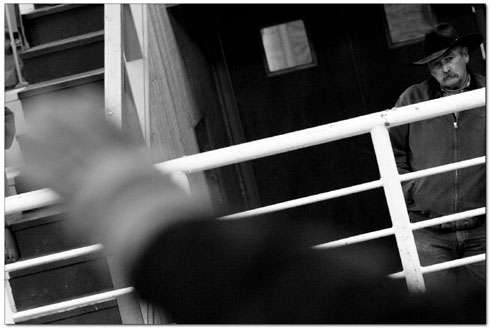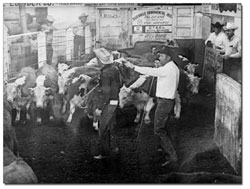|
| ||||||
| Sale Barn surives in La Plata County
by Jeff Mannix When Noah marched all those breeding pairs onto the ark back even before chewing gum or ballpoint pens were invented, where do you suppose he got those animals? He surely didn’t just whistle from atop the mast; there were habitats to consider, and some were far away or underground or in noisy places. History has neglected this critical bit of information, but the answer has been obvious for a million years if only we had just paused to follow the tracks or sniff the scent. Noah had to arrange for order buyers to purchase and ship all these denizens from the four corners of the Earth, and thus begat the livestock auction – a marketplace that precedes all others and predates what, for all this time, we’ve thought to be the oldest profession in the world. The farther you get away from concrete, the closer you get to a livestock auction. Every rural region across the globe has always had and continues to have a “sale barn,” and La Plata County, Colorado, USA, is no exception. High-Country Cattle Auction, west of town on the La Plata Highway in Breen, is Durango’s stock brokerage. Owned and operated by three generations of the Cugnini family, High-Country Cattle Auction opens its 35 acres of pens and its auction ring every Tuesday at 1 p.m. for the sale of cattle. “We have room for 1,500 head of cattle, five loading chutes for the big potbelly trucks, a ring with seating capacity of 200, and a scale that will weigh 40 head at once,” explains Duane Cugnini, the second generation owner and market maker at High-Country. Duane got his start in the livestock-selling business when he was a kid, penning cattle for his father, Pat, at Basin Livestock auction, where Home Depot now covers history. “Most of the time,” says Duane, “we sell 400 to 600 head a week, and as many as 1,000 on fall shipping sales.” This is half of what they used to sell 10 or 15 years ago, however. The reason for this becomes obvious driving across the county and seeing mile after mile of new houses and barbless-wire boxing in what’s left of the great cattle ranches that once dominated the landscape and economy. But cattle are expensive – around $600-plus per head – so even with today’s restraints, High-Country Cattle Auction has potential to sell almost $3 million worth of cattle a year. It’s a real business supporting a real market and determining the cost of beef and the livelihood of a landed segment of the community. It requires15 to 20 people to conduct a sale at High-County Cattle Auction, and it’s not simply a matter of hauling in old Bessie, crossing your fingers and hoping someone in the audience will spring for a reasonable price. Cugnini, if he wants to bring sellers back time after time, must make the market price at every one of his sales. “Everyone today knows what every class of cattle is bringing nationwide; you just have to go online to find out, and I have to be sure that every head that goes through my ring hits that mark or has some noticeable reason not to,” says Cugnini in a tone reminiscent of a Merrill Lynch broker.
“I’m prepared to buy every animal that comes through my ring, if I have to, to keep the market true and keep my customers coming back,” adds Cugnini with a shudder. “We have been with First National Bank in Durango for longer than I can remember, and they allow me to keep this business true to the market and afloat.” The auction ring is theater. Cugnini, perched high above with the auctioneer and recording secretary, is the producer. “I start the bids, based on the type and age of the animals, their condition and that day’s price adjusted for regional conditions,” says Cugnini. The yard crew then moves animals into the ring with no delays – stopping the action dispels the tension in theater. They work on horses, on foot with dogs, or in the sorting pens swinging steel gates and ensuring cattle are on the scales and ready to enter the ring the moment the heavy door swings open. Then the drama of auction is in the hands of the leading man: the auctioneer. “A good auctioneer is key to a successful sale,” boasts Cugnini, himself a veteran auctioneer. “He must know his buyers, set the pace and build the excitement. Some are real artists, and livestock auctioneers are like no other auctioneer. The pace of bidding is very fast, always changing in dollars or half-dollars or even quarters.” It’s high drama, whether you’re a buyer or a seller. Hands get cold, armpits drip, mouths dry up, and as the animal being sold or bought goes into the ring, time stops and only your ears and sense of doom seem to be working. The sing-song babble of the auctioneer drones on, a practiced chant that keeps the ear focused on the current bid that’s obscured by the hypnotic blabber coaxing for the next price. “We have two kinds of buyers at a livestock auction,” explains Cugnini, “the order buyer who has feedlot customers and large ranchers who pasture calves until they reach feedlot weight. Then we have local ranchers who want specific kinds of cattle to add to their herds or have extra feed in any one year and find more profit in feeding and selling cattle than selling feed.” On the flip side, most sellers are La Plata County locals. “Our sellers are mostly local – within a couple of hundred miles – and the regulars are cow/calf operators who sell their weanlings here,” Cugnini says. “I make a point of knowing them all, knowing what they need and when they need it – I spend a lot of time visiting customers and gauging when they’ll be at the sale, then calling the buyers to let them know what’s coming.” Back in 1985, Pat Cugnini decided to enter the video auction market, which was just coming into its own and required a cameraman to visit each ranch to videotape calves for sale. Pat and Duane hired local film maker Tony Schweikle, schlepped him around over muddy roads to videotape herds, then booked the Diamond Circle Theatre and advertised for buyers to attend. “We did this for four or five years, but it got a little too drunk to want to keep it up,” says Duane with a laugh. “On the first sale, I bumped into an older man wearing a cowboy hat in the lobby of the Strater Hotel. He asked me what was going on in the Diamond Circle, and I told him we were having a video cattle auction and encouraged him to come by. He came in with his son and they took seats. My dad started the auction and this guy bid on and bought the first lot we auctioned. Then he bought the second, the third, the forth, and kept buying.” Duane then recalls, “My dad stopped the auction for a minute and asked me who is that guy. ‘I don’t know,’ I said, ‘I just ran into him in the lobby.’ So my dad walks off the stage and right over to this guy, introduces himself and says, ‘Can you afford to pay for all these cattle you’re buying?’ and the guy says, ‘I can afford to buy everything you got to sell here today, Mr. Cugnini.’ So dad looks him in the eye, nods his head at him, gets a nod back, and goes back to selling cattle, mostly to this stranger.” Duane then concludes with a hearty laugh. “I’ve visited this rancher a number of times down in Texas. He’s the real thing, and the cattle business still works to a great extent on a handshake and a nod.” •
|
In this week's issue...
- May 15, 2025
- End of the trail
Despite tariff pause, Colorado bike company can’t hang on through supply chain chaos
- May 8, 2025
- Shared pain
Dismal trend highlights need to cut usage in Upper Basin, too
- April 24, 2025
- A tale of two bills
Nuclear gets all the hype, but optimizing infrastructure will have bigger impact




